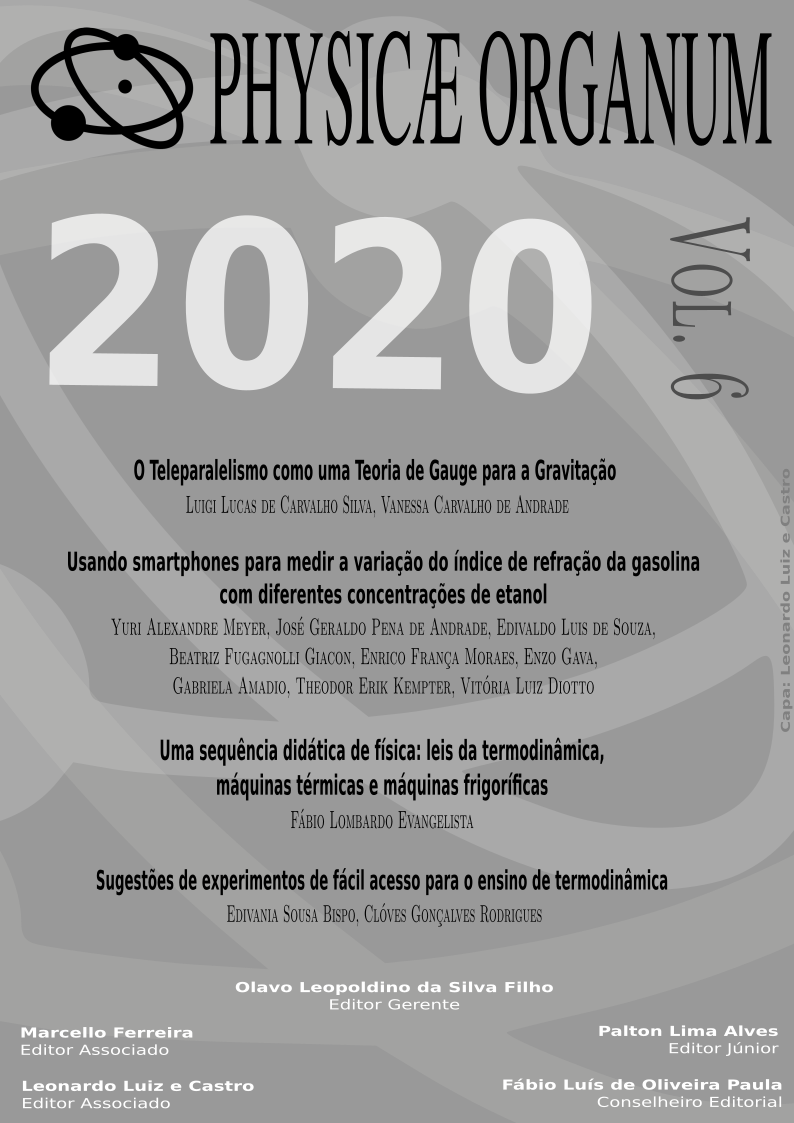Using smartphones to measure the variation in the refraction index of gasoline with different ethanol concentrations
Keywords:
Physics Teaching, Chemistry Teaching, Refraction, Smartphones.Abstract
The present work, characterized as a Junior Scientific Initiation (ICJ), allowed high school students to have the first contact with scientific knowledge SI. It is mainly characterized by an interdisciplinary project between Chemistry and Physics. The research presents a new methodology that reconciles the variation of ethanol concentration in gasoline with the variation of refraction indices of the media through the use of a bequer and a PVC Pipe, and taking several pictures with smartphones (for each concentration). The refraction index is determined by the size of the diameters of the real part of the tube (outside the Bequer) and the part that is immersed in the solution. In the experimental work, from the analysis of pure gasoline samples with different pre-defined concentrations of ethanol, values of different refraction indexes were obtained, and when plotting the data, it was possible to observe a behavior not Linear. In addition to this mathematical behavior, the experiment allows, from the data, to analyze factors such as molar refraction.
References
ANDRADE, R. da S.; VIANA, K. da S. L. Atividades experimentais no ensino da química: distanciamentos e aproximações da avaliação de quarta geração. Ciênc. Educ., Bauru, v. 23, n. 2, p. 507-522,2017.
BUENO, L. et al. O ensino de química por meio de atividades experimentais: a realidade do ensino nas escolas. Universidade Estadual Paulista, 2007. Acesso em 17 de jun., 2019, unesp.br/prograd/ENNEP/...%2520Encontro%2520de%2520Ensino/T4.pdf.
CARVALHO, F. I.; FILHO, H. A. D. Estudo da qualidade da gasolina tipo A e sua composição química empregando análise de componentes principais, Quim. Nova, V. 37, pg. 33-38, 2014.
FALATE, R. et al. Fiber optic sensors for hydrocarbon detection. Sensors and Actuators B, vol. 105, pp. 430-436, 2005.
LOPES, E. B.; AGUIAR, C. E. Um método simples para medir o índice de refração de líquidos. XX Simpósio Nacional de Ensino de Física ”“ SNEF 2013 ”“ São Paulo, SP, pg.1-6, 2013.
PAULO, I. J. C.; MOREIRA, M. A. Abordando Conceitos Fundamentais de Mecânica Quântica no nível médio. Revista da Associação Brasileira de Pesquisa em Educação em Ciências, Bauru - São Paulo, v. 4, p. 63 ”“ 73, 2004.
RAUBER, A. G.; QUARTIERI, M. T.; DULLIUS, M. M. Contribuições das atividades experimentais para o despertar científico de alunos do ensino médio. R. bras. Ens. Ci. Tecnol., Ponta Grossa, v. 10, n. 1, p. 1-12, 2017.
REGINALDO, C. C.; SHEID, N. J.; GÜLLICH, R. I. da C. O ensino de ciências e a experimentação. IX ANPED SUL - Seminário de Pesquisa em Educação da Região Sul, pg. 1-13, 2012.
SCHWAHN, M. C. A.; OAIGEN, E. R. Objetivos para o uso da experimentação no ensino de química: a visão de um grupo de licenciandos. VII Enpec Encontro Nacional de Pesquisas em Educação em Ciências, Florianópolis, 8 nov. 2009. Acesso em 20 jun., 2019, posgrad.fae.ufmg.br/posgrad/viienpec/pdfs/933.pdf.
WADEKAR, M. P. et al. Refractive index, density, molar refraction and polarizability constant of substituted-2,3-dihydroquinazolin-4(1H)-ones in different binary mixture. Journal of Chemical and Pharmaceutical Research, v.7, pg. 242-248, 2015.
ZHANG, T. et al. A single-element interferometer for measuring refractive index of transparente liquids. Optics Communications, v.332, pg. 14”“17, 2014.
Downloads
Published
Issue
Section
License
Copyright (c) 2020 Physicae Organum

This work is licensed under a Creative Commons Attribution-NonCommercial-ShareAlike 4.0 International License.
Autores que publicam nesta revista concordam com os seguintes termos:
Autores mantém os direitos autorais e concedem à revista o direito de primeira publicação, sendo o trabalho simultaneamente licenciado sob a Creative Commons Attribution License o que permite o compartilhamento do trabalho com reconhecimento da autoria do trabalho e publicação inicial nesta revista.
Autores têm autorização para assumir contratos adicionais separadamente, para distribuição não-exclusiva da versão do trabalho publicada nesta revista (ex.: publicar em repositório institucional ou como capítulo de livro), com reconhecimento de autoria e publicação inicial nesta revista.
Autores têm permissão e são estimulados a publicar e distribuir seu trabalho online (ex.: em repositórios institucionais ou na sua página pessoal) a qualquer ponto antes ou durante o processo editorial, já que isso pode gerar alterações produtivas, bem como aumentar o impacto e a citação do trabalho publicado (Veja O Efeito do Acesso Livre).




